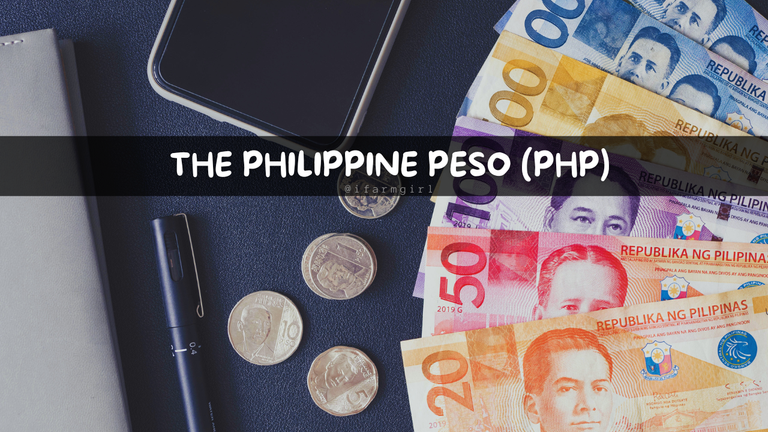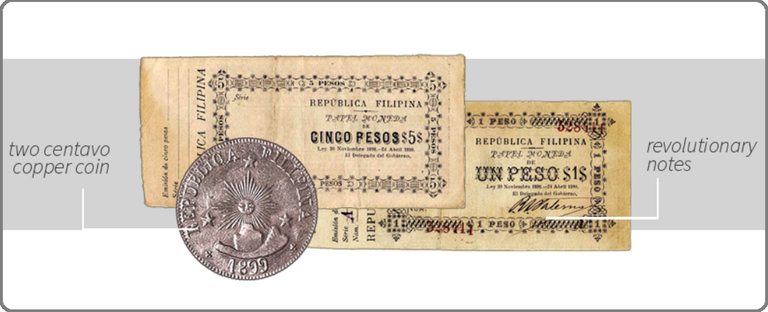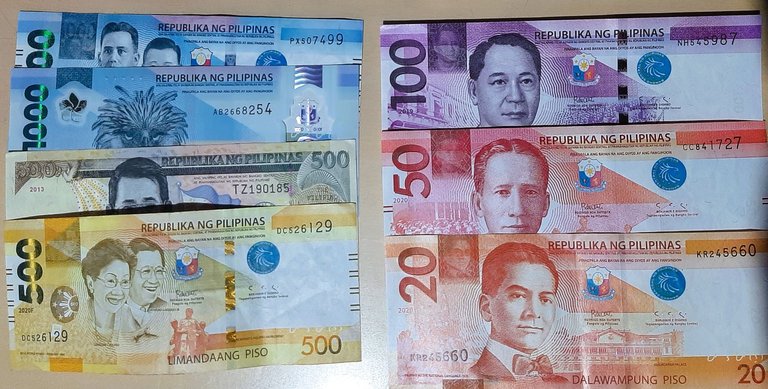The Philippine Currency [PHP]
The Philippines has quite a history and so is its currency. Some of which I did not even know until today. Before having a currency, the country used a barter system for the exchange of goods and services. Then the country was colonized by the Spaniards and the Spanish Pesos were used. Then a currency system was established during the American regime (1899 to 1946).

Philippine Currencies
The Philippine government first issued its own coins and notes in 1898 when the country gained its independence from the Spaniards. However, the currencies were short-lived because they went out of circulation and were deemed illegal during the American rule. A new monetary system was introduced and the Philippine currency was pegged to the US dollar at a 2:1 ratio (Php 2 = 1 USD).¹
 [The first notes and coin by the Philippine Government in 1898, courtesy of BSP].
[The first notes and coin by the Philippine Government in 1898, courtesy of BSP].Additionally, during the Second World War, the Japanese government issued war notes which had no reserves. So two currencies were in circulation at those times until the war ended.²
Immediately after the country regained its independence, it had its first banknotes printed with the denominations of 1, 2, 5, 10, 20, 50, 100, and 500. There were English series that circulated between 1949 to 1969. Then during the Marcos era, the Pilipino and the Bagong Lipunan were printed. It was replaced by the New BSP series in 1985 until 2018. Then there's the New Generation Currency (NGC) from 2010 to the present.³
Current Bills/Banknotes
Unlike the US dollar paper notes, our bills are quite colorful, each denomination is different from the other.

The country's notes and coins, including their designs and styles, have undergone a series of changes over the years. At present, we have 20, 50, 100, 200, 500, and 1000 in paper bills. 25 cents, 1 peso, 5 peso, 10 and 20 peso coins. Some denominations were discontinued and are no longer in circulation.
Here's how our paper bill size is to the US dollar. They have the same width but ours might be 5mm longer.

Philippine Foreign Exchange Market
While the country's currency had a fixed peg of PHP2:$1 during the American regime, the peg was broken after 1946 when black markets for pesos appeared which set their own rate at 3:1. Even with the creation of the country's central bank (Bangko Sentral ng Pilipinas) in 1949, the currency struggled to maintain the 2:1 peg. The exchange rate was unstable. In 1965, the peg was set to PHP3.90/$1. the currency was devalued, and by 1986, the trading rate was at Php20 to a dollar.⁴
The country's Foreign exchange policy evolved from a pegged to a floating rate system in 1970 when the Central Bank of the Philippines abandoned the fixed rate system and allowed competitive rates to play. Foreign exchange restrictions and trading bands were lifted around 1972.⁵ Then the New Central Bank Act of 1993 officially set and transitioned the peso to a free-floating currency where the market forces determine the exchange rate and eliminated the black markets.
The currency has undergone devaluation over time. Today, the exchange rate fluctuates between 55 and 56 to the dollar. Two decades ago, it was 35 to $1. I still remember when one peso was able to buy lots of candies back when we were kids. Now, it can only purchase a piece.
Exchange Channels
These days, people can easily exchange Philippine Pesos for other foreign currencies (or vice versa), from online platforms to over-the-counter channels (malls, banks, exchange centers). Anyone from overseas visiting the country can quickly find exchangers almost everywhere.
In addition, crypto can be conveniently exchanged for the country's fiat currency through various methods and platforms. Crypto exchanges like Coins.PH and Binance P2P allow users to transact and easily convert cryptocurrencies like Bitcoin and Stablecoins like USDT to the Philippine Peso. Likewise, it's pretty easy to buy crypto using PHP.
Summing Up
It was interesting to learn how the country's currency system evolved from the Spanish regime to date.
It was quite historical and the currency has seen reforms, policies, and changes that impacted it from being fixed-pegged to the dollar to becoming a free-floating currency.
Over the years, I have experienced the currency's devaluation and can certainly tell the difference. So I wouldn't be surprised to see further changes during this digital era. I do hope it's going to be for the better.
Lead image created on Canva. Screenshot linked directly to the source. No copyright infringement intended. Other photos are my own. 04032024/20:48ph
Posted Using InLeo Alpha
This post has been manually curated by @steemflow from Indiaunited community. Join us on our Discord Server.
Do you know that you can earn a passive income by delegating to @indiaunited. We share more than 100 % of the curation rewards with the delegators in the form of IUC tokens. HP delegators and IUC token holders also get upto 20% additional vote weight.
Here are some handy links for delegations: 100HP, 250HP, 500HP, 1000HP.
100% of the rewards from this comment goes to the curator for their manual curation efforts. Please encourage the curator @steemflow by upvoting this comment and support the community by voting the posts made by @indiaunited.
Thanks as always!
!HUG
!LOL
lolztoken.com
Nobody nose.
Credit: mimismartypants
@ifarmgirl, I sent you an $LOLZ on behalf of myintmo.shweyi
(1/4)
Delegate Hive Tokens to Farm $LOLZ and earn 110% Rewards. Learn more.
!LUV !HBIT
@ifarmgirl mined HBIT. ⛏️ (1/1) tools | trade | connect
Made with LUV by crrdlx.
myintmo.shweyi, ifarmgirl sent you LUV. 🙂 (4/10) tools | trade | connect | daily
Made with LUV by crrdlx.
I sent 1.0 HUG on behalf of @myintmo.shweyi.
(2/3)
I sat down and read the post because I enjoyed the historical background.
One of this days I will also study how some of my country's national values evolved. Thanks for entertaining and educating me 🥰
Thank you, I'm glad you enjoyed the read. Hope you get to check your country's history too and share them with us :)
!PIZZA
😀 Yes I will. I'm equally proud of my country.
Ako'y walang alam bout jan din haha. Receive lang ng pera 😂
Haha! Ngayon ko din lang nalaman na fixed rate pala dati yung peso natin 😅
!LADY
View or trade
LOHtokens.@ifarmgirl, you successfully shared 0.1000 LOH with @jane1289 and you earned 0.1000 LOH as tips. (2/23 calls)
Use !LADY command to share LOH! More details available in this post.
The PHP seems to be doing good. After demonetization in India, here also, we have some colorful notes floating in the market. haha
!luv
ifarmgirl, splash-of-angs63 sent you LUV. 🙂 (1/5) tools | trade | connect | daily
Made with LUV by crrdlx.
Colorful notes are good :) They brighten our wallets, haha!
!PIZZA
Thanks for taking us through the history of the Philippine currency! It's fascinating to see how it evolved over time, from the barter system to being pegged to the US dollar and finally transitioning to a free-floating currency!
Yeah, I just learned some of my country's history through this :) Thank you !LADY
View or trade
LOHtokens.@ifarmgirl, you successfully shared 0.1000 LOH with @madilyn02 and you earned 0.1000 LOH as tips. (3/23 calls)
Use !LADY command to share LOH! More details available in this post.
And I'm happy to learn that you are from the Philippines, I love the movies hehe 💜
alwsys good to keep these information. After all irrency is what keep the economy going.
Yep. It's funny that I only learned about our currency having a fixed peg to the dollar before.
!PIZZA
I really love the writing. The history and the facts you present were lovely. And learned many things about the Philippines's currency. Thansk for sharing.
Many thanks, I'm glad you like how it was done :)
!LUV
guurry123, ifarmgirl sent you LUV. 🙂 (5/10) tools | trade | connect | daily
Made with LUV by crrdlx.
The Philippine currency has a very nice history and I’m so glad to know about it
Thanks for sharing
Thank you !LADY. I had a good time researching about it :)
View or trade
LOHtokens.@ifarmgirl, you successfully shared 0.1000 LOH with @rafzat and you earned 0.1000 LOH as tips. (4/23 calls)
Use !LADY command to share LOH! More details available in this post.
This is a beautiful piece. Every nation has its evolution of money. It's interesting to read about that of the Philippines.
Thanks. You are right, every place has its own history :)
!PIZZA
$PIZZA slices delivered:
ifarmgirl tipped mfontom
ifarmgirl tipped steemflow
ifarmgirl tipped splash-of-angs63
@ifarmgirl(5/5) tipped @newbreed
May museum dito sa min, merong mga bills and coins na gamit nila nung World War 2. Hehe
Galing din noh. Old coins lang ang nakita ko, yung mga malalaki 😅
!PIZZA
During those times, coins still had so much value that the size, weight, and cost of metals used to manufacture those coins almost didn't matter. 🤓
!LUV
ifarmgirl, savvytester sent you LUV. 🙂 (10/10) tools | trade | connect | daily
Made with LUV by crrdlx.
Quite the first time I am actually seeing their currency though
Glad you saw them here first 😅 !LADY
View or trade
LOHtokens.@ifarmgirl, you successfully shared 0.1000 LOH with @precab and you earned 0.1000 LOH as tips. (5/23 calls)
Use !LADY command to share LOH! More details available in this post.
The currency look so colorful and attractive.
Thanks for sharing this beautiful history with us, I really enjoyed the story behind the currency
Thank you. It's a pleasure to share. !PIZZA
Quite an evolution of your currency and I liked the history behind it.
The notes are indeed very colourful.
Yeah. It was interesting to learn about it. Thank you, !LADY
View or trade
LOHtokens.@ifarmgirl, you successfully shared 0.1000 LOH with @edith-4angelseu and you earned 0.1000 LOH as tips. (1/23 calls)
Use !LADY command to share LOH! More details available in this post.
How manage that we have not been hearing about the Philippines money all this while actually
Well, if you are not interested into something, you won't check it out so that might be the case :D
https://twitter.com/lee19389/status/1765316802265989324
#hive #posh
The Philippines' currency have beautiful faces on them but that 1000 bill has the face of a hawk or some animal, can't really say.
You have a very rich cultural history and you should be proud of it 😊
Thank you. They are people who made a difference in the country a long time ago.
It's the Philippine Eagle on the 1k bill :-)
!LUV
tranquil3, ifarmgirl sent you LUV. 🙂 (1/10) tools | trade | connect | daily
Made with LUV by crrdlx.
The economy and currency value of a country depends on its economic stability. The challenges such as inequality, poverty, poor education, limited healthcare access, lack of foreign investment, and corruption create significant obstacles. These challenges that Philippines faces as well as Pakistan.